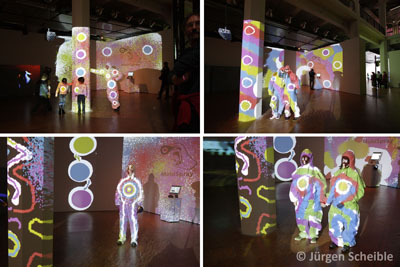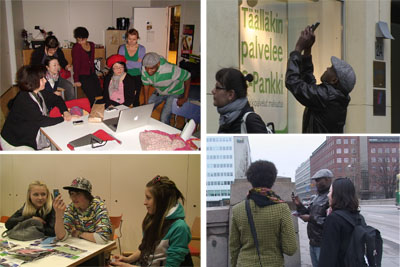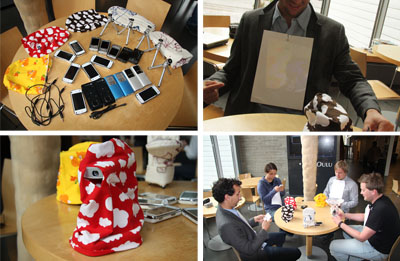The 'RealUbi' research partner project (2009 - 2011) of Media Lab at Aalto University School of Art and Design was funded by Tekes, the Finnish Funding Agency for Technology and Innovation. It was part of a larger research project of the multidisciplinary UBI ('UrBan Interactions') research program of University of Oulu (http://www.ubioulu.fi). The UrBan Interactions' program brings together researchers from engineering, computer science, architecture, business, art, economics, design and cultural anthropology. In collaboration with the City of Oulu it has built a functional prototype of a future ubiquitous city in Oulu, Finland. It is furnished with new pervasive computing infrastructure at downtown Oulu in form of interactive public displays, large-scale projectors, and different wireless networks including a city-wide WiFi network providing open and free Internet access to general public.

The unique infrastructure of ubiquitous technology enables new type of interaction between the citizens and technology. Ubiquitous city stands for an urban space in which information technology is being harnessed invisibly and effectively for the use of processes taking place in the space. The objective is to create an urban environment in which better services are being offered to the people of the city. The additional value produced by the infrastructure and services for the users of the urban space is being studied systematically by collecting quantitative and qualitative data with different methods.
Within the context of the UrBan Interactions program, the RealUbi partner project of Media Lab focused in particular on generating new knowledge that informs future design of multi-modal interfaces in urban spaces. This concerned applications, devices, models, techniques and services for urban interaction. With a technology driven exploration approach and an iterative rapid prototyping process we designed and explored applications such as creative applications for enabling artistic creations, fostering togetherness, urban communities and an art inspired lifestyle. The project produced a series of outcomes in form of scientific publications, workshops, artistic works, videos and presentations.
Project manager, Researcher, Post-Doc researcher: Dr. Jürgen Scheible
Research director: Prof. Lily Diaz
Results
International Awards:
Jürgen Scheible received Best Speaker Award at TECHNARTE, an international conference on Art and Technology in Bilbao, Spain on 16.4.2010
Scientific publications:
Díaz, Lily & Ekman, Ulrik (2011). “Mobile Ubiquity in Public and Private Spaces”, Special Issue of Digital Creativity, Taylor Francis, Vol. 22. No. 3.
Scheible J. (2011). Interactive snow sculpture painting. In PART 2 Proceedings of the 2011 annual conference extended abstracts on Human factors in computing systems (CHI EA '11). ACM, New York, NY, USA, 503-504.(Download PDF)
Scheible J. (2010). 'Multimodal art tools for creating and sharing interactive engaging experiences', In: Selke S & Dittler U (eds.) Postmediale Wirklichkeiten aus interdisziplinärer Perspektive. Heise Zeitschriften Verlag, Hannover, Germany, 2010, 223-238.
Shamma D.A., Scheible J., Sheppard R. (2009) Graffiti dance: interaction of light, information, and environment. Proc. Seventh ACM Conference on Creativity and Cognition (C&C 2009), Berkeley, CA, USA, 479-480. (Download PDF)
Shamma D.A., Sheppard R., Scheible J. (2010) Human to dancer interaction - Designing for embodied performances in a participatory installation. Proc. 8th ACM Conference on Designing Interactive Systems (DIS2010), Aarhus, Denmark, 356-359. (Download PDF)
Doctoral dissertations:
Scheible J. (2010) Empowering Mobile Art Practice: A Recontextualization of Mobile and Ubiquitous Computing. Dissertation, Aalto University, School of Art and Design, publication series 107, Helsinki, Finland, 212 p. (Download PDF)
International presentations:
29.9.2009, Berkeley USA, ACM Creativity & Cognition 2009 conference, Graffiti Dance performance, Jürgen Scheible
8.11.2009, Pittsburgh USA, Art && Code symposium at Carnegie Mellon University, Creative Mobile Phone Programming with Python & Nokia Phones, Jürgen Scheible
16.4.2010, Bilbao, Spain, TECHNARTE international conference on Art and Technology, The Mobile Phone as Spray Can for creating Ephemeral Digital Art, Jürgen Scheible
6.5.2010, Bergen, Norway, Nordic Media Festival, ‘The Mobile Artist’, Jürgen Scheible
5.11.2010, New York, USA, ‘Painting Flatiron’-MobiSpray event, MobiSpray performance, Jürgen Scheible
5.2.2011, Oberderdingen, Germany, ‘Art Inside’ Cultural festival, MobiSpray performance, Jürgen Scheible
18.-19.2.2011, Leuven, Belgium, Kulturama 2011 (cultural festival), MobiSpray performance, Jürgen Scheible
28.2.2011, Karlsruhe, Germany, ’TV Komm’ conference, MobiSpray performance, Jürgen Scheible
3.3.2011, Bretten, Germany, ’Paint my school’ MobiSpray event, ‘The mobile phone as art tool’ and MobiSpray performance, Jürgen Scheible
11.5.2011, Vancouver, Canada, CHI2011 conference, ‘Interactive snow sculpture’ video presentation, Jürgen Scheible
National presentations
18.1.2010, Helsinki University, MobiSpray event, MobiSpray performance, Jürgen Scheible
27.1.2010, Helsinki, Otaniemi Open House 2010, MobiToss & MobiSpray show case, Jürgen Scheible
27.2.2010, Helsinki, ’Mobile Dev Camp’, Python for S60, Jürgen Scheible
27.5.2010, Aalto University, Dissertation defense event, Media department, ‘Empowering Mobile Art Practice: A Recontextualization of Mobile and Ubiquitous Computingon’, Jürgen Scheible
31.5.2010 Oulu University, Ubi-summer school 2010, Creating and Sharing Artistic Experiences with Ubiquitous Technology, Jürgen Scheible
20.1.2011, Helsinki, “The Culture of Ubiquitous Information” seminar of the Nordic Research Network, ‘Mobile Art - Creating and Sharing Artistic Experiences with Ubiquitous Technology’, Jürgen Scheible
Art Exhibitions:
1.-30.11.2010, UBI-hotspots Gallery in Oulu, exhibition of MobiSpray art works, Jürgen Scheible
14.5.-4.6.2010, Lume Galleria Helsinki, ‘Paint my city’ MobiSpray art work exhibition, Jürgen Scheible (in conjunction with doctoral defence event).
4.-6.2.2011, Oberderdingen, Germany, ‘Art Inside’ exhibition at Forum Oberderdingen, MobiSpray ‘Paint my city’ art work exhibition, Jürgen Scheible
Media coverage:
12 5.11.2010, Business Wire, Famed Artists to Paint Historic Flatiron Building Using MobiSpray. (View PDF)
27.1.2011 Badische Neueste Nachrichten (Germany), Lichtgraffiti für Wolkenkratzer. (View PDF)
18.2.2011 Leuven Nieuws (Belgium), Graffiti uit eem GSM. (View PDF)
7.2.2011 Badische Neueste Nachrichten (Germany), Eine imposante Graffiti-Fläche. (View PDF)
17.2.2011, Brettener Woche (Germany), Heisse Rhythmen und kalte Performance. (View PDF)
7.3.2011 Badische Neueste Nachrichten (Germany), MobiSpray macht die Schule bunt. (View PDF)
17.3.2011 Brettener Woche (Germany), Schüler besprayen virtuell Schulgebäude. (View PDF)
TV apperances:
18.1.2011 Finnish national TV MTV3 news, Helsinki University MobiSpray-event
18.1.2010, Finnish national TV YLE news, Helsinki University MobiSpray-event
18.2.2011, Belgian national TV news, MobiSpray at Kulturama 2011 Leuven
18.2.2011, ROB TV (Leuven, Belgium), MobiSpray at Kulturama 2011 Leuven
28.2.2011, Kraichgau TV, Germany, MobiSpray ESG school painting
Artistic activities:
Helsinki University, MobiSpray event, MobiSpray performance by Jürgen Scheible
Interactive snow sculpture painting, CHI EA '11 accepted video.
ZKM Karlsruhe 20th anniversary, MobiSpray performances

Paint my School MobiSpray event, ESG Bretten, Germany 3.3.2011
Sub projects:
Life breather
Life Breather is a tool to make static objects in the physical environment talk and become ‘alive' while interacting with them. Through this, the objects obtain a human voice and can speak for the purpose of telling a story. The story is not a pre-made story done by cultural heritage experts or artists; it is a recording of the thoughts that are triggered in a persons mind at the moment when she looks at the object. Often when looking at an object in a museum or a statue outdoors, it triggers some thoughts in our head. These thoughts might be related to our previous knowledge about the object, some experience or own cultural understandings or maybe just fantasy and fiction. The important issue here is, that the story gets told and recorded from the object’s point of view. In this way it is like one are breathing life into the object.

The Life Breather tool is a mobile phone application which works in such a way that you take first a photo of the object. After that the photo shows on the phone screen and the voice recording starts automatically, giving you 15 seconds time to tell the story by speaking into the phone’s microphone. A timer is shown on the phone screen to know when the recording has stopped automatically. The result of each recording is a clip that contains an image and sound clip. All clips are stored locally on the phone and can be accessed and played through gallery functionality. Additionally to the recorded clips there is other metadata collected such as the time of the recording and its geolocation in form of GPS coordinates. Once a series of clips is recorded they can be ‘stitched’ into one film, ready for an audience to view for the purpose of revisiting the moments when objects were made alive. All clips that have been collected locally on the mobile device are uploaded via Wireless Lan to a server that automates the film-making. The film can contain the clips of multiple phones – turning it into a collectively created movie.
This sub project brought together diverse areas of knowledge including information design, interaction design, multimodal interface design, mobile computing research and development, concepts from digital cultural heritage and performance art in order to create a collectively realized experimental movie. Information design techniques for example, were used to create maps that were distributed to test-participants.
Life Breather was tested in the city of Helsinki following a journey designed for a group of users to engage and express themselves and their interaction with Cultural Hertage artifacts. MA students Chao An, Anukka Salo and visiting scholar Jiayu Wu, prepared maps before the test event. The maps contained descriptions of an exploration path to be followed by the participants as well as illustrations of pre-identified artifacts or cultural artifacts found on these journeys.
See and download journey maps: map1 , map2 , map3
Documentation video: Life_Breather_testing.mov
Project lead: Prof Lily Diaz
Research assistants: Chao An, Anukka Salo, Jiayu Wu
Researcher: Dr. Helena Oikarinen-Jabai
Application idea & Technical lead: Jürgen Scheible
Graffiti Dance
The graffiti dance installation project was a collaboration project between Jürgen Scheible of Aalto University and David Shamma of Yahoo Research! in California as well as Renata Sheppard of University of Illinois at Urbana-Champaign.

Graffiti Dance is based on Jürgen Scheible's MobiSpray application. Graffiti Dance allows the audience to graffiti paint with light onto a buildings side and receive immediate local feedback from a set of dancers choreographed to respond to the movement on the public display. The installation is a holistic experience using a plurality of sources (syndicated news Images and Twitter) and local influences (from mobile uploads) that reflect our understanding of the world around us, how we speak out in public forums, and how we interpret the creative act.
Project lead: Jürgen Scheible
Mobile Pico-Projector project
This sub project explored the use of mobile pico-projectors for creating and sharing artistic activities in public space. An application was designed and programmed which connected 8 pico projectors and 8 mobile phones into a real-time streetart platform.

The project was realized during the international Ubi Summer school of University of Oulu in Summer 2010.
Project lead: Jürgen Scheible